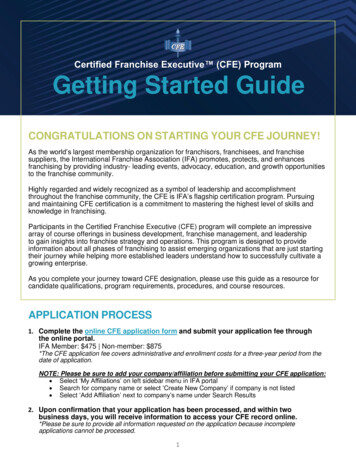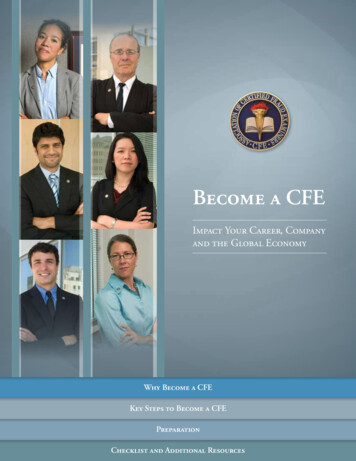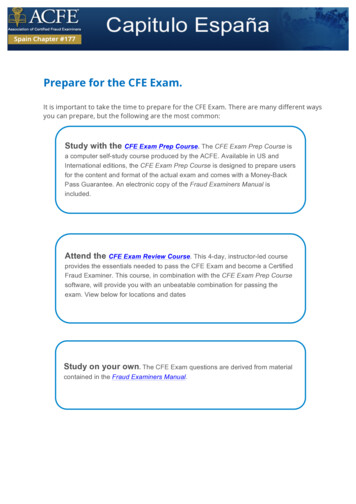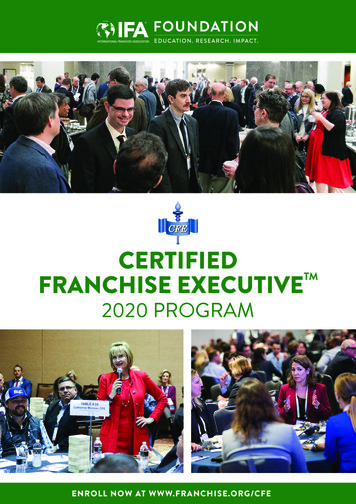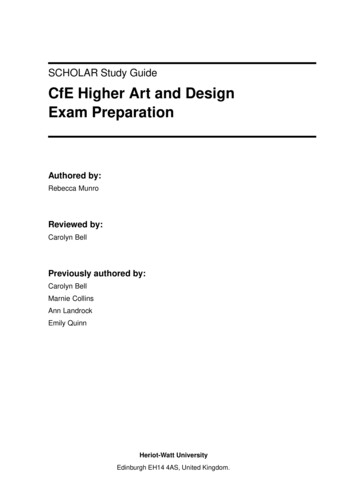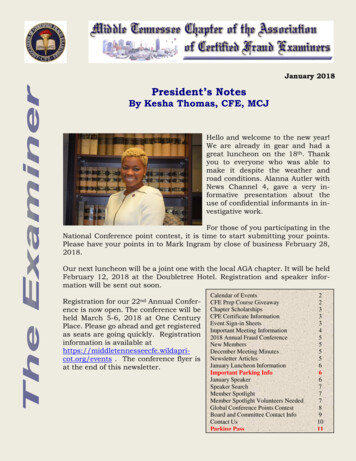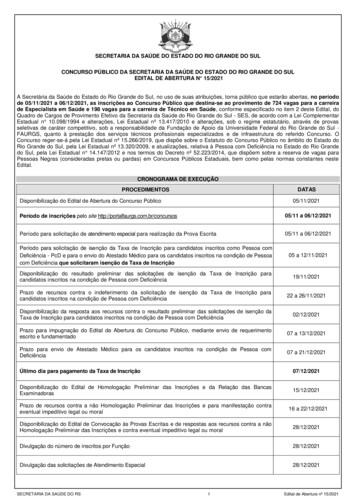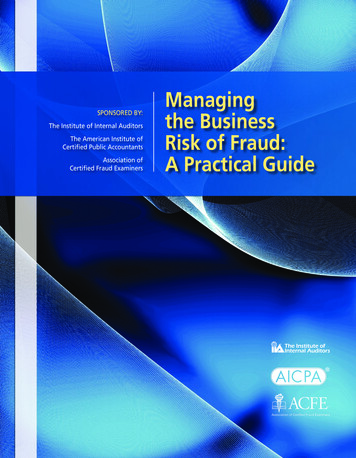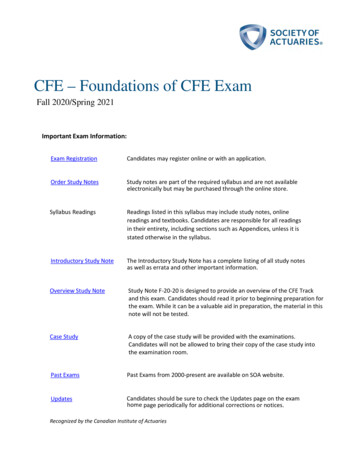
Transcription
CFE – Foundations of CFE ExamFall 2020/Spring 2021Important Exam Information:Exam RegistrationCandidates may register online or with an application.Order Study NotesStudy notes are part of the required syllabus and are not availableelectronically but may be purchased through the online store.Syllabus ReadingsReadings listed in this syllabus may include study notes, onlinereadings and textbooks. Candidates are responsible for all readingsin their entirety, including sections such as Appendices, unless it isstated otherwise in the syllabus.Introductory Study NoteThe Introductory Study Note has a complete listing of all study notesas well as errata and other important information.Overview Study NoteStudy Note F-20-20 is designed to provide an overview of the CFE Trackand this exam. Candidates should read it prior to beginning preparation forthe exam. While it can be a valuable aid in preparation, the material in thisnote will not be tested.Case StudyA copy of the case study will be provided with the examinations.Candidates will not be allowed to bring their copy of the case study intothe examination room.Past ExamsPast Exams from 2000-present are available on SOA website.UpdatesCandidates should be sure to check the Updates page on the examhome page periodically for additional corrections or notices.Recognized by the Canadian Institute of Actuaries
Corporate Finance and ERM – Foundations ExamFall 2020/Spring 20211. Topic: Corporate FinanceLearning ObjectivesThe candidate will understand how a company optimizes its corporate finance decisions based on its businessobjectives.Learning OutcomesThe Candidate will be able to:a)Recommend an optimal capital structure for given business objectives and the competitive environmentb) Compare and contrast methods to determine the value of a business or project, including the impact oncapital budgeting and allocation decisionsc)Evaluate the impact of non-financial factors on capital structure or capital budgeting decisionsd) Assess the impact of business strategies such as acquisitions, divestitures, and/or restructuringsResources Corporate Finance, Berk, Jonathan and Demarzo, Peter, 4th Edition, 2017oCh. 8: Fundamentals of Capital Budgeting (background only)oCh. 18: Capital Budgeting and Valuation with LeverageoCh. 22: Real OptionsoCh. 25: LeasingoCh. 27: Short-Term Financial PlanningoCh. 28: Mergers and AcquisitionsoCh. 31: International Corporate Finance F-132-17: Capital Structure, Executive Compensation, and Investment Efficiency F-133-19: Ch. 10 of the Handbook of Corporate Finance: Empirical Corporate Finance, Volume 2 F-134-19: Ch. 15 of Damodaran on Valuation, Damodaran, 2nd Edition, 2006 F-135-19: Why are the Parts Worth More than the Sum; “Chop Shop,” A Corporate Valuation Model, pp. 80100 F-136-19: Ch. 4 of Corporate Value Creation, Governance and PrivatisationF-137-19: Hurdle Rates, Cost of Capital & Capital Structure: CFO Spotlight1
Corporate Finance and ERM – Foundations ExamFall 2020/Spring 20212. Topic: Financial Statement AnalysisLearning ObjectivesThe candidate will understand how to gauge a company’s performance through an evaluation of its financialreports.Learning OutcomesThe Candidate will be able to:a)Analyze the reported financial statements and the interrelationships among them, in order to measurea corporation’s financial performanceb) Identify and analyze the impact of unusual accounting practices on the quality of earnings and assets ofa corporation, including analyzing the signs of questionable accountingc)Analyze the impact of tax accounting and policies, local regulations, and foreign exchange ratesResources International Financial Statement Analysis, Robinson et al, 4th Edition, 2020oCh. 6: Financial Analysis TechniquesoCh. 9: Income TaxesoCh. 11: Financial Reporting QualityoCh. 15: Multinational OperationsoCh. 17: Evaluating Quality of Financial Reports (sections 1-6)Note: If you want to refresh your knowledge on Financial Statements, Ch. 1-5 of the International FinancialStatement Analysis book may be useful.2
Corporate Finance and ERM – Foundations ExamFall 2020/Spring 20213. Topic: Enterprise Risk Management & Operational ExcellenceLearning ObjectivesThe candidate will understand how to apply and recommend appropriate ERM framework, principles andstrategies to manage, evaluate, analyze and mitigate risk exposures faced by an entity and to ensureoperational excellence in any industry.Learning OutcomesThe Candidate will be able to:a)Assess the potential impact of risks faced by an entity in any industryb) Recommend best practices in risk measurement, modeling, and management of various financial andnon-financial risksc)Develop and evaluate an appropriate risk mitigation or risk transfer strategy for any given situationd) Recommend best practices to achieve operational excellencee)Design, analyze and develop ERM strategies for financial and non-financial companiesResources Enterprise Risk Management Models, Olson, David L. and Wu, Desheng Dash, 3rd Edition, 2020oCh. 1: Enterprise Risk Management in Supply ChainoCh. 3: Value-Focused Supply Chain Risk AnalysisoCh. 4: Examples of Supply Chain Decisions Trading Off CriteriaoCh. 5: Simulation of Supply Chain RiskoCh. 6: Value at Risk ModelsoCh. 7: Chance Constrained ModelsoCh. 8: Data Envelopment Analysis in Enterprise Risk ManagementoCh. 9: Data Mining Models and Enterprise Risk ManagementoCh. 10: Balanced Scorecards to Measure Enterprise Risk PerformanceManaging Business Process Flows, Anupindi, R., Chopra, S. and Deshmukh, S., 3rd Edition, 2012oCh. 1: Products, Processes and PerformanceoCh. 2: Operations Strategy and Management F-138-20: A Framework for Board Oversight of Enterprise Risk, CPA Canada, pp. 1-112 F-140-19: The Costs and Benefits of Reinsurance, pp. 4-22 F-142:19: An Analysis of Delta Air Lines’ Oil Refinery Acquisition F-146-20: 2012 Fuel Hedging at Jetblue Airways F-151-20: Ch. 11 of Foundations of Airline Finance: Methodology and Practice, 3rd Edition, 2019, pp.482-5103
Corporate Finance and ERM – Foundations ExamFall 2020/Spring 20214. Topic: Quantitative MethodsLearning ObjectivesThe candidate will understand the application of quantitative methods with a risk management focus tobusiness problems.Learning OutcomesThe Candidate will be able to:a)Assess methods and processes for quantifying and managing risk within any business enterpriseb) Evaluate model risks and processesc)i.Assess model tradeoffs among usefulness, resource constraints, timeliness, fidelity, andaccuracyii.Assess processes for vetting modelsEvaluate results of deterministic, stress-testing, stochastic and simulation methods and modelsResources Measuring Market Risk, Dowd, Kevin, 2nd Edition, 2005oCh. 9: Applications of Stochastic Risk Measurement MethodsoCh. 13: Stress TestingoCh. 15: Backtesting Market Risk ModelsoCh. 16: Model RiskFundamentals of Machine Learning for Predictive Data Analytics, Kelleher, John D., Mac Namee, Brian andD’Arcy, Aoife, 2015oCh. 2: Data to Insights to Decisions (background only)oCh. 3: Data Exploration (background only)oCh. 8: EvaluationoCh. 9: Case Study: Customer ChurnoCh. 10: Case Study: Galaxy ClassificationoCh. 11: The Art of Machine Learning for Predictive Data Analytics F-131-16: Heavy Models, Light Models and Proxy Models, sections 1-5 & 7 (excluding Appendices) F-139-19: How to Improve Quality of Stress Tests Through Backtesting (excluding Appendices) F-147-20: Chapter 11 of Modelling in Life Insurance a Management Perspective F-148-20: A Guide to Risk Measures, Capitol Allocation & Related Decision Support Issues ASOP 56: Modeling, Dec 2019 (excluding Appendices)4
Corporate Finance and ERM – Foundations ExamFall 2020/Spring 20215. Topic: Advanced Techniques for Non-hedgeable RisksLearning ObjectivesThe candidate will understand advanced techniques to identify, evaluate and manage complex and not easilytransferrable (non-hedgeable) risks in financial and non-financial organizations.Learning OutcomesThe Candidate will be able to:a)Evaluate the extent to which risks are hedgeable or non-hedgeableb) Apply frameworks or methods to evaluate non-hedgeable risksc)Assess strengths and biases of techniques to measure risks given limited information for a range ofbusiness situationsd) Evaluate the efficacy of different approaches to managing non-hedgeable risks, including risk capitalpositions, operational risk management practices, risk mitigation and transfer strategiese)Assess drawbacks and other costs to risk transfer solutions versus other internal risk managementapproaches for non-hedgeable risksResources How to Measure Anything, Hubbard, Douglas W., 3rd Edition, 2014oCh. 9: Sampling Reality: How Observing Some Things Tells Us about All ThingsoCh. 11: Preference and Attitudes: The Softer Side of MeasurementoCh. 13: New Measurement Instruments for ManagementoCh. 14: A Universal Measurement Method: Applied Information Economics F-113-14: Securitization, Insurance and Reinsurance F-140-19: The Costs and Benefits of Reinsurance, pp. 4-22 F-143-19: Managing Supply Chain Disruptions, sections 2-5 F-149-20: Catastrophe Bonds: An Important New Financial Instrument F-150-20: A Fundamental Approach to Cyber Risk Analysis F-152-20: Demystifying the Risk Margin: Theory, Practice and Regulation (excluding section 3) F-153-20: Commodity Hedging – The Advent of a New Paradigm F-154-20: Is Longevity an Insurable Risk? Hedging the Unhedgeable5
Overview Study Note Study Note F-20-20 is designed to provide an overview of the CFE Track and this exam. Candidates should read it prior to beginning preparation for the exam. While it can be a valuable aid in preparation, the material in this note will not be tested. Case Study A copy of the case study will be provided with the examinations.
